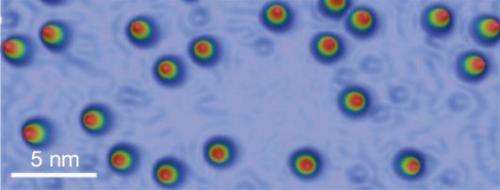November 14, 2013 report
Researchers find a way to stabilize the magnetic moment of a single holmium atom

(Phys.org) —A team of physicists working at Karlsruhe Institute of Technology in Germany, has developed a way to cause the magnetic moments of individual holmium atoms placed on a conductive metallic base to survive for several minutes. The team describes their procedure in their paper published in the journal Nature.
Scientists have been studying single magnetic atoms and groups of them (when placed on non-magnetic surfaces) to learn whether they might be used for very high density storage devices or perhaps even as a part of a quantum computer. In order to use them in such ways, though, scientists must first figure out a way to prevent the destabilization that results from interactions with stray photons or electrons. In this new effort, the team in Germany has found a way to get a group of one type of magnetic atom to remain stabilized for up to several minutes—several orders of magnitude longer than previous results by other researchers. To obtain that result, the researchers isolated single holmium atoms in a near absolute zero environment and then placed them on a platinum substrate.
Scientists believe magnetic atoms may provide the benefits they seek due to their quantum nature. It should be possible, theory suggests, to store information using the spin magnetic moment of an atom. By adjusting the spin state (as either down or up) a single bit of information can be stored, so long as it can be held in that state long enough for processing. Thus far, attempts to create a system that does so have been thwarted by destabilizations that occur when photons or stray electrons enter the system causing a change to the spin, and nullifying the information that was held. Improvements have been found by reducing the temperature to near absolute zero, but until now, researchers have only been able to hold the spin state steady for a few milliseconds—not nearly long enough for processing purposes.
To get the system to hold steady longer, the team in Germany came up with a specific symmetrical way to arrange the atoms as they were placed on the substrate which caused the holmium atoms to be invisible to stray electrons. That reduced the destabilization enough to allow the spin state to be held steady for approximately 10 minutes—more than enough time to perform processing tasks.
More information: Stabilizing the magnetic moment of single holmium atoms by symmetry, Nature 503, 242–246 (14 November 2013) DOI: 10.1038/nature12759
Abstract
Single magnetic atoms, and assemblies of such atoms, on non-magnetic surfaces have recently attracted attention owing to their potential use in high-density magnetic data storage and as a platform for quantum computing. A fundamental problem resulting from their quantum mechanical nature is that the localized magnetic moments of these atoms are easily destabilized by interactions with electrons, nuclear spins and lattice vibrations of the substrate. Even when large magnetic fields are applied to stabilize the magnetic moment, the observed lifetimes remain rather short (less than a microsecond). Several routes for stabilizing the magnetic moment against fluctuations have been suggested, such as using thin insulating layers between the magnetic atom and the substrate to suppress the interactions with the substrate's conduction electrons, or coupling several magnetic moments together to reduce their quantum mechanical fluctuations7, 8. Here we show that the magnetic moments of single holmium atoms on a highly conductive metallic substrate can reach lifetimes of the order of minutes. The necessary decoupling from the thermal bath of electrons, nuclear spins and lattice vibrations is achieved by a remarkable combination of several symmetries intrinsic to the system: time reversal symmetry, the internal symmetries of the total angular momentum and the point symmetry of the local environment of the magnetic atom.
Journal information: Nature
© 2013 Phys.org


















